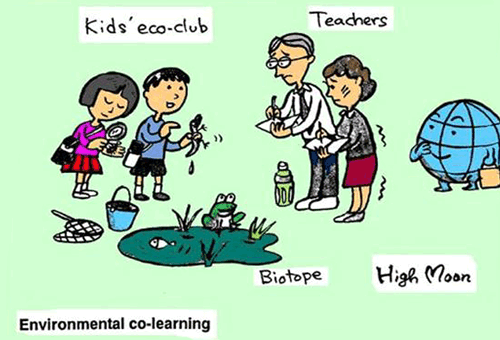"Community Wisdom Bank" is a community site to share the "wisdom" with people
around the world and to create a sustainable world!!
- 8-point Traditional Japanese Wisdom
-
- Mind over attachment to things
- Harmony with Nature
- Learning to be Content
- Idea of Circulation
- Maintaining Harmony
- Freedom of Mind
- Living based on Respect for Ancestors and Predecessors
- Caring for and Nurturing the Future Generations
Caring for and Nurturing the Future Generations


- illustration : copyright (c) Hiroshi takatsuki
Learning in the Edo period was not confined to educational institutions such as terakoya, han schools and private schools. The local community, workplace and other places also offered learning opportunities that helped to nurture the future generations. Also, it was customary for the whole community -- and not just parents ? to celebrate the birth of a child as community members gladly gave a helping hand in childcare. A mechanism that enables inclusive, participatory childcare and education, such as the one found in the Edo period, would be all the more important in our contemporary society as an element that supports social and human sustainability.
Traditional wisdom lives on
Community-based School Lunch Project in Nagano’s Nagatani District, Ina City that Supports Children’s Dietary Lifestyle
In 1963, a junior high school in Nagatani District, Ina City in Nagano Prefecture in central Japan became the first school in the nation to introduce a “lunch room” where all students can sit together for lunch. In a break from the traditional style of eating lunch at classroom desks, this unconventional lunch room format was realized at the strong request of the schoolmaster at the time. He believed that getting together for school lunches would provide an opportunity for more comprehensive education that extends to behavioral and moral aspects, an idea that drew the support of village administration and residents. Then in 1989, a group of women from local farming households organized the “Mugiwara Boshi-no-Kai,” (Straw Hat Group), a group dedicated to supplying safe farm products to the school’s students. Thanks to their efforts, the school kitchen now uses farm produce supplied by this group as much as possible. This attempt exemplifies the collaborative efforts of local administration and community members, in addition to educational institutions, to bring up children in a sound, supportive environment.
Is this another illustration of “wisdom?”
- Abacus and calligraphy schools that still dot cities and towns in Japan
- The baby sling for strapping a baby to one’s back, and a feeling of warm connection with the baby it brings
- Local events for exchanges among different generations, such as gathering for annual rice-cake making
- Terakoya (private educational institutions that taught writing and reading to the children of Japanese commoners during the Edo period)
- The Japanese word kodakara, literally meaning “child treasure,” representing the idea that a child is a gift from heaven
- top page
- Traditional wisdom
lives on - Comments from visitors
Comments from visitors
Let us know your comments on this topic !
Let us know your comments on this topic !
Please click here, move to Questionnaire page
- top page
- Traditional wisdom
lives on - Comments from visitors
All Rights Reserved.

